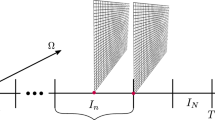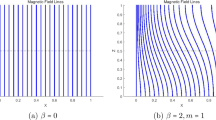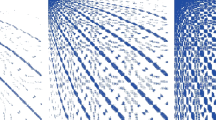Abstract
In this paper, based on the boundary approximation approach for parallelization of the compact difference schemes, a novel strategy for the sub-domain boundary approximation schemes is proposed to maintain consistent accuracy and dispersion with the compact scheme in the interior points. In this strategy, not only the order of accuracy of the sub-domain boundary scheme is the same as the interior scheme, but the coefficient of the first truncation error term is also equal to that of the internal scheme. Furthermore, to realize the consistent dispersion performance for a class of high order upwind compact schemes, which usually include two expressions, we modify the opposite expression to be the sub-domain boundary scheme. As an example of application, the present strategy is applied to a fourth-order upwind compact scheme, and its accuracy is verified by a numerical test. The resolution and efficiency of the newly proposed parallel method are examined by four numerical examples, including propagation of a wave-packet, convection of isentropic vortex, Rayleigh–Taylor instability problems, and propagation of Gauss pulse. The results obtained demonstrate that the present strategy for compact difference schemes has the feasibility to solve the flow problems with high accuracy, resolution and efficiency in parallel computation.











Similar content being viewed by others
Availability of Data and Materials
The data generated during and analyzed during the current study are available from the corresponding author on reasonable request.
References
Lele, S.K.: Compact finite difference schemes with spectral-like resolution. J. Comput. Phys. 103(1), 16–42 (1992)
Bodony, D.J., Lele, S.K.: Current status of jet noise predictions using large-eddy simulation. AIAA J. 46(2), 364–380 (2008)
Schaupp, C., Sesterhenn, J., Friedrich, R.: On a method for direct numerical simulation of shear layer/compression wave interaction for aeroacoustic investigations. Comput. Fluids 37(4), 463–474 (2008). https://doi.org/10.1016/j.compfluid.2007.02.007
Fu, D.X., Ma, Y.W., Li, X.L.: Direct numerical simulation of three-dimensional Richtmyer–Meshkov instability. Chin. Phys. Lett. 25(1), 188–190 (2008). https://doi.org/10.1088/0256-307X/25/1/051
Laizet, S., Lamballais, E.: High-order compact schemes for incompressible flows: a simple and efficient method with quasi-spectral accuracy. J. Comput. Phys. 228(16), 5989–6015 (2009). https://doi.org/10.1016/j.jcp.2009.05.010
Laizet, S., Li, N.: Incompact3d: a powerful tool to tackle turbulence problems with up to O(105) computational cores. Int. J. Numer. Methods Fluids 67(11), 1735–1757 (2011). https://doi.org/10.1002/fld.2480
Tian, Z.F., Yu, P.X.: An efficient compact difference scheme for solving the streamfunction formulation of the incompressible NavierStokes equations. J. Comput. Phys. 230(17), 6404–6419 (2011). https://doi.org/10.1016/j.jcp.2010.12.031
Oguic, R., Viazzo, S., Poncet, S.: A parallelized multidomain compact solver for incompressible turbulent flows in cylindrical geometries. J. Comput. Phys. 300, 710–731 (2015). https://doi.org/10.1016/j.jcp.2015.08.003
Yu, P.X., Tian, Z.F., Zhang, H.: A rational high-order compact difference method for the steady-state stream functionvorticity formulation of the NavierStokes equations. Comput. Math. Appl. 73(7), 1461–1484 (2017). https://doi.org/10.1016/j.camwa.2017.01.024
Yu, P.X., Tian, Z.F.: An upwind compact difference scheme for solving the streamfunction-velocity formulation of the unsteady incompressible Navier-Stokes equation. Comput. Math. Appl. 75(9), 3224–3243 (2018). https://doi.org/10.1016/j.camwa.2018.01.043
Harten, A., Lax, P.D., Leer, B.V.: On upstream differencing and Godunov-type schemes for hyperbolic conservation laws. SIAM Rev. 25(1), 35–61 (1983)
Fu, D.X., Ma, Y.W.: High resolution scheme. In: Hafez, M., Oshima, K. (eds.) Computational Fluid Dynamics Review, pp. 234–250. Wiley, New York (1995)
Tolstykh, A.I., Lipavskii, M.V.: On performance of methods with third-and fifth-order compact upwind differencing. J. Comput. Phys. 140(2), 205–232 (1998)
Ma, Y.W., Fu, D.X., Kobayashi, T., Taniguchi, N.: Numerical solution of the incompressible Navier–Stokes equations with an upwind compact difference scheme. Int. J. Numer. Methods Fluids 30(5), 509–521 (1999)
Li, X.L., Ma, Y.W., Fu, D.X.: High efficient method for incompressible N-S equations and analysis of two-dimensional turbulent channel flow. Acta Mechanica Sinica (2001) (in Chinese)
He, Z.W., Li, X.L., Fu, D.X., Ma, Y.W.: A 5th order monotonicity-preserving upwind compact difference scheme. Sci. China (Phys. Mech. Astron.) 54(3), 511–522 (2011)
Tam, C.K., Webb, J.C.: Dispersion-relation-preserving finite difference schemes for computational acoustics. J. Comput. Phys. 107(2), 262–281 (1993)
Tian, Z.F., Liang, X., Yu, P.X.: A higher order compact finite difference algorithm for solving the incompressible Navier–Stokes equations. Int. J. Numer. Methods Eng. 88(6), 511–532 (2011). https://doi.org/10.1002/nme.3184
Qin, Q., Xia, Z.A., Tian, Z.F.: High accuracy numerical investigation of double-diffusive convection in a rectangular enclosure with horizontal temperature and concentration gradients. Int. J. Heat Mass Transf. 71, 405–423 (2014). https://doi.org/10.1016/j.ijheatmasstransfer.2013.12.035
Sun, X.: Application and accuracy of the parallel diagonal dominant algorithm. Parallel Comput. 21(8), 1241–1267 (1995). https://doi.org/10.1016/0167-8191(95)00018-J
Gaitonde, D., Visbal, M.: Further development of a Navier–Stokes solution procedure based on higher-order formulas. In: 37th Aerospace Sciences Meeting and Exhibit 557 (1999)
Povitsky, A., Morris, P.J.: A higher-order compact method in space and time based on parallel implementation of the Thomas algorithm. J. Comput. Phys. 161(1), 182–203 (2000). https://doi.org/10.1006/jcph.2000.6497
Ladeinde, F., Cai, X., Visbal, M.R., Gaitonde, D.: Parallel implementation of curvilinear high-order formulas. Int. J. Comput. Fluid Dyn. 17(6), 467–485 (2003). https://doi.org/10.1080/10618560310001615060
Sengupta, T.K., Dipankar, A., Rao, A.K.: A new compact scheme for parallel computing using domain decomposition. J. Comput. Phys. 220(2), 654–677 (2007)
Chao, J., Haselbacher, A., Balachandar, S.: A massively parallel multi-block hybrid compact-WENO scheme for compressible flows. J. Comput. Phys. 228(19), 7473–7491 (2009)
Kim, J.W., Sandberg, R.D.: Efficient parallel computing with a compact finite difference scheme. Comput. Fluids 58, 70–87 (2012)
Kim, J.W.: Quasi-disjoint pentadiagonal matrix systems for the parallelization of compact finite-difference schemes and filters. J. Comput. Phys. 241, 168–194 (2013). https://doi.org/10.1016/j.jcp.2013.01.046
Capuano, F., Mastellone, A.: Parallelization of compact finite-volume schemes for turbulent compressible flow. In: Proceedings of 27th International Conference on Parallel Computational Fluid Dynamics, 2015. (2015)
Abide, S., Binous, M.S., Zeghmati, B.: An efficient parallel high-order compact scheme for the 3D incompressible Navier–Stokes equations. Int. J. Comput. Fluid Dyn. 31(4–5), 214–229 (2017). https://doi.org/10.1080/10618562.2017.1326592
Naik, N.H., Naik, V.K., Nicoules, M.: Parallelization of a class of implicit finite difference schemes in computational fluid dynamics. Int. J. High Speed Comput. 5(01), 1–50 (1993)
Terekhov, A.V.: A highly scalable parallel algorithm for solving Toeplitz tridiagonal systems of linear equations. J. Parallel Distrib. Comput. 87, 102–108 (2016)
Larsson, J., Gustafsson, B.: Stability criteria for hybrid difference methods. J. Comput. Phys. 227(5), 2886–2898 (2008)
Povitsky, A., Wolfshtein, M.: Multidomain implicit numerical scheme. Int. J. Numer. Methods Fluids 25(5), 547–566 (1997)
Yu, S., Tsai, Y., Hsieh, K.: Runge–Kutta methods combined with compact difference schemes for the unsteady Euler equations. In: 28th Joint Propulsion Conference and Exhibit, 19923210 (1992)
Van Leer, B.: Flux-vector splitting for the Euler equations. In: Eighth International Conference on Numerical Methods in Fluid Dynamics, pp. 507-512. Springer, Berlin (1982)
Sharp, D.H.: An overview of Rayleigh–Taylor instability. Physica D 12(1), 3–18 (1984). https://doi.org/10.1016/0167-2789(84)90510-4
Samtaney, R., Pullin, D.I.: On initial value and self similar solutions of the compressible Euler equations. Phys. Fluids 8(10), 2650–2655 (1996). https://doi.org/10.1063/1.869050
Shi, J., Zhang, Y., Shu, C.: Resolution of high order WENO schemes for complicated flow structures. J. Comput. Phys. 186(2), 690–696 (2003)
Waddell, J.T., Niederhaus, C.E., Jacobs, J.W.: Experimental study of Rayleigh—Taylor instability: low Atwood number liquid systems with single-mode initial perturbations. Phys. Fluids 13(5), 1263–1273 (2001). https://doi.org/10.1063/1.1359762
Tian, Z.F.: A rational high-order compact ADI method for unsteady convection–diffusion equations. Comput. Phys. Commun. 182(3), 649–662 (2011). https://doi.org/10.1016/j.cpc.2010.11.013
Carpenter, M.H., Gottlieb, D., Abarbanel, S.: Stable and accurate boundary treatments for compact, high-order finite-difference schemes. Appl. Numer. Math. 12(1–3), 55–87 (1993)
Carpenter, M.H., Gottlieb, D., Abarbanel, S.: Time-stable boundary conditions for finite-difference schemes solving hyperbolic systems: methodology and application to high-order compact schemes. J. Comput. Phys. 111(2), 220–236 (1994)
Carpenter, M. H., Kennedy, C. A.: Fourth-order 2N-storage Runge–Kutta schemes Nasa Technical Memorandum, 1–26 (1994)
Kennedy, C.A., Carpenter, M.H., Lewis, R.M.: Low-storage, explicit Runge–Kutta schemes for the compressible Navier–Stokes equations. Appl. Numer. Math. 35(3), 177–219 (2000)
Acknowledgements
This work was supported in part by the National Natural Science Foundation of China under Grant 11502054 and 11872151, National Science and Technology Major Project, Ministry of Science and Technology of China, Grant/Award Number: 2017-II-0007-0021, Special Program for Applied Research on Super Computation of the NSFC-Guangdong Joint Fund (the fourth phase). The authors are grateful to the referees for helpful comments and suggestions which improved the quality of the paper considerably.
Author information
Authors and Affiliations
Corresponding author
Additional information
Publisher's Note
Springer Nature remains neutral with regard to jurisdictional claims in published maps and institutional affiliations.
Appendices
Appendix A
The following is to apply the compact fourth-order central difference scheme in conjunction with sixth-order central difference scheme for parallel calculation of the first partial derivative in the same way as Sect. 2.2.3.
If Eq. (24) is assumed to be a sixth-order accuracy scheme, a sixth-order sub-domain boundary scheme at \(i=1\) can be constructed with the coefficients \(a_k\) solved as follow
The expression of truncation errors is
Comparisons of the effects that the sub-domain boundary scheme has on the \(L_{\infty }\)-norm errors between numerical results and exact results as well as the convergence order are shown in Table 8.
In general, the parallel differencing systems with sixth-order sub-domain boundary scheme provide fourth-order accuracy throughout the domain. However, the \(L_{\infty }\)-norm errors calculated by the parallel algorithm using sixth-order sub-domain boundary scheme is always 1.2 times the serial results, while that of the parallel algorithm using fourth-order sub-domain boundary scheme with consistent coefficient of first truncation error term are almost equal to the serial results. According to the Eq. (21), since \(\alpha _{-1}=\alpha _{1}=\frac{1}{4}\) and \(C_e=0\), then
which indicates that the error of the actual approximation near the boundary is at least 20% greater than the serial one. This is exactly verified by the numerical results.
Appendix B
The following is to extended our approach to match the second truncation error terms in addition and see if it improves the result for parallel calculation of the first partial derivative in the same way as Sect. 2.2.3.
An explicit central difference scheme based on eight-point stencils is taken into account here. For instance, when \(i=1\) it can be expressed as
If Eq. (77) is assumed to be a fourth-order accuracy scheme and the approximation \(F_1\) has the same coefficient of first and second truncation error term as Eq. (22), the coefficients \(a_n\) can be solved that
Comparisons of the effects that the sub-domain boundary scheme has on the \(L_{\infty }\)-norm errors between numerical results and exact results as well as the convergence order are shown in Table 9.
Compared to Table 1, the extension to match the second truncation error terms does improve the results, especially when the grids size is small. This shows that for the case of small number of grid points per process, in order to minimize the discrepancies and improve the results, if enlarging the size of sub-boundary scheme stencils is available, we can expand our approach to match the second truncation error term or even more.
Appendix C
If the explicit schemes is employed as the sub-domain boundary schemes for the parallelization of CCU45, in order to meet the proposition in Sect. 2.1 for consistent accuracy and to have DRP property, the explicit schemes based on a seven-point stencil is required. Consider the following explicit schemes:
-
(a)
EC7 scheme:
$$\begin{aligned} {F}_{bound\ i}=\frac{1}{h}\sum _{n=-3}^{3}a_{n}u_{i+n}. \end{aligned}$$(79) -
(b)
E7U4 scheme:
$$\begin{aligned} {F}_{bound\ i}=\frac{1}{h}\sum _{n=-4}^{2}b_{n}u_{i+n}. \end{aligned}$$(80) -
(c)
E7U5 scheme:
$$\begin{aligned} {F}_{bound\ i}=\frac{1}{h}\sum _{n=-5}^{1}c_{n}u_{i+n}. \end{aligned}$$(81)
The integrated error \(E(d_0)\) is defined as follows.
where r is a factor to determine the optimization integration range, \(d_0\) represents \(b_0\) or \(c_0\), and \(W(\omega )\) is a weighting function.
In fact, the EC7 scheme is a central difference scheme and its dispersion relation can not be optimized by changing \(a_0\). One can impose the conditions that E7U4 and E7U5 schemes are accurate to fourth-order and keep the coefficient of first truncation error term consistent with Eq. (49). These leave one of the coefficients, note \(b_0\) or \(c_0\), as a free parameter. This parameter can then be chosen to minimize the error integral E of Eq. (82). After carrying out the constrained minimization, the coefficients can be found, which are shown in Tables 10, 11 and 12.
With the use of Fourier transform, the modified wavenumber defined in Eq. (50) \(k_e\left( \omega \right) =k_{r}\left( \omega \right) +\text{ j } k_{i}\left( \omega \right) \) of the schemes can be obtained. The profiles of the imaginary part \(k_{i}\) of each scheme as well as the CCU45 scheme are shown in Fig. 4. Under the consideration of not employing too many halo points for data transfer, we find that it is difficult to improve the resolution characteristics of the explicit sub-domain boundary scheme by optimization with one or two extra halo points.
Rights and permissions
About this article
Cite this article
Chen, J., Yu, P., Ouyang, H. et al. A Novel Parallel Computing Strategy for Compact Difference Schemes with Consistent Accuracy and Dispersion. J Sci Comput 86, 5 (2021). https://doi.org/10.1007/s10915-020-01383-x
Received:
Revised:
Accepted:
Published:
DOI: https://doi.org/10.1007/s10915-020-01383-x




